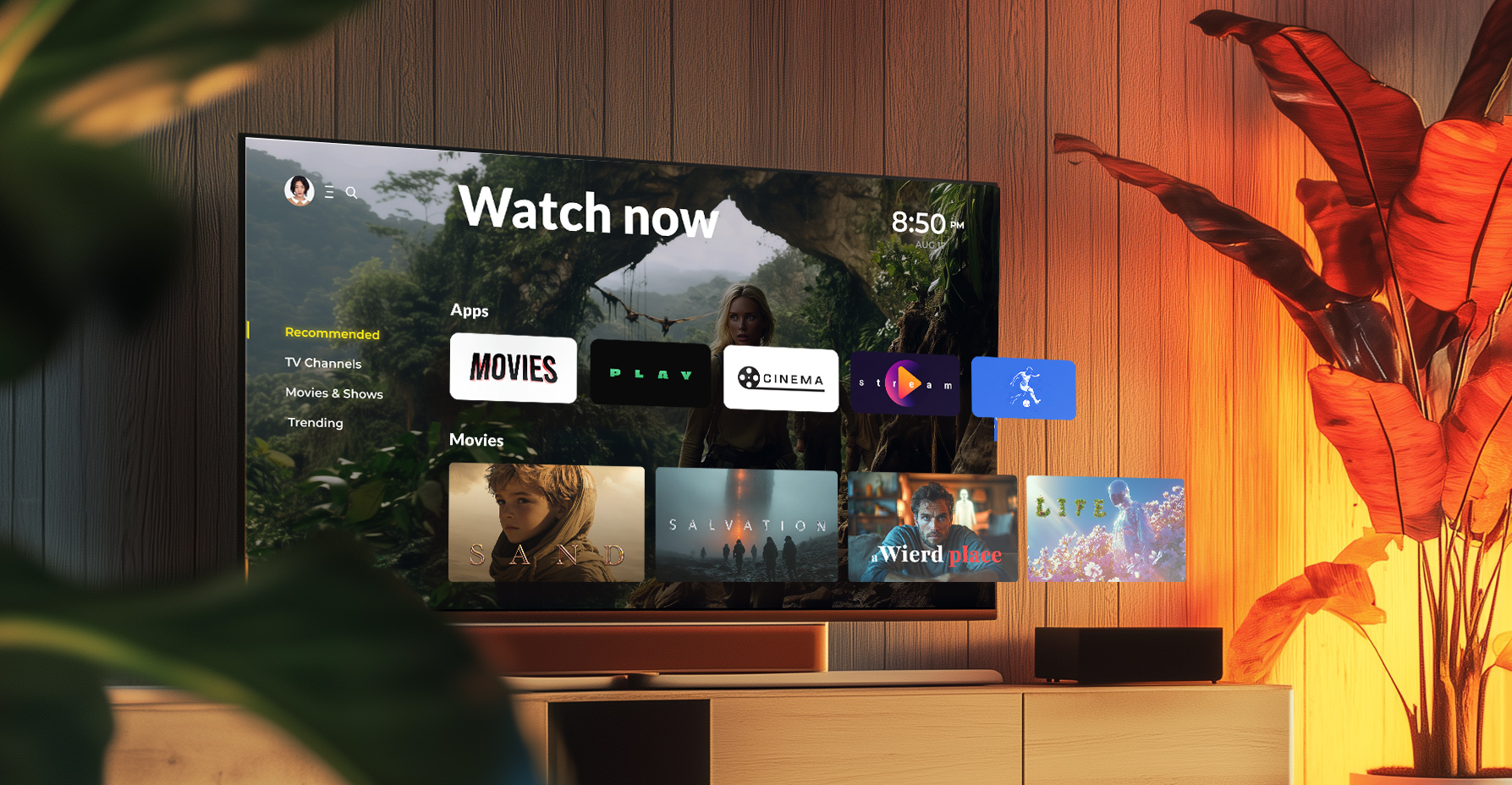There are two kinds of video that reach viewers’ screens: the kind that rides the open roads of the internet — and the kind that travels a private highway.
The first one is OTT (Over-the-Top). The second — IPTV (Internet Protocol Television). And though the boundaries between the two are shifting and operators embrace hybrid models, behind the scenes they live on very different maps. For those building and evolving these platforms, there’s a long road with many forks. So, here’s your map through the real world of IPTV app development — historical stops, technical landmarks, and a few honest warnings where the road gets bumpy.
First stop: quick campfire FAQ on IPTV
Before we venture deep into IPTV terrain, let’s gather around and answer the most common questions — a crash course from our in-house expert to help you pack smart for the journey ahead.
What is IPTV?
It’s television delivered over IP, but not via the open internet. Instead, it uses closed, operator-managed networks — like a private highway for content.
How does it work?
Operators provide IPTV through their dedicated infrastructure, often via a broadband connection. Viewers usually need special hardware, like a set-top box (STB), to access the content.
How’s it different from OTT?
OTT services deliver video content via the public internet, accessible through any Internet Service Provider, application, or smart TV, offering flexibility and broad reach. In contrast, IPTV operates within an operator’s private, controlled network, ensuring efficient and reliable content delivery. Picture OTT as a bustling public highway, open to all, while IPTV is a dedicated toll road, optimized for speed and control within a closed ecosystem.
Another key factor is CDN and cloud costs. OTT platforms rely on Content Delivery Networks (CDNs) and cloud servers to distribute video globally, ensuring smooth playback under peak traffic. These services charge based on bandwidth usage, storage, and scaling demands, making costs unpredictable as user numbers grow. IPTV, however, operates within closed infrastructure, reducing reliance on external CDNs and lowering expenses. Essentially, OTT pays for every stream crossing the internet, while IPTV manages traffic within its private lanes — both approaches shaping the economics of content delivery.
Historical landmark: the dawn of IPTV
Picture the early 2000s: Netflix is shipping DVDs, and the idea of streaming video online is pure fantasy, with dial-up connections barely managing emails. Enter IPTV (Internet Protocol Television), a trailblazing technology that sidestepped the internet’s limitations by harnessing telecoms’ private networks.
Pioneers like France Télécom (now Orange) and AT&T, veterans of 1980s and 1990s analog pay-per-view and VHS rentals, seized the chance to reinvent video delivery. By 2001–2003, they rolled out “triple-play” packages — bundling internet, phone, and TV — using controlled networks to deliver seamless content.
The secret weapon was multicast technology, which dodged the bandwidth bottlenecks of the public internet. Early IPTV set-top boxes, powered by Linux or custom firmware, brought live TV and early video-on-demand into homes. The appeal was clear: reliable, high-quality content delivered through local networks, unaffected by the public internet’s instability, set the stage for today’s streaming revolution.
Why are telecom providers still riding the IPTV track?
Even in the age of Netflix and YouTube, IPTV didn’t get off the road — it just changed vehicles. Operators saw a cost-saving opportunity in multicast technology.
With multicast, one video stream can be delivered to thousands — even millions — of viewers simultaneously, without duplicating bandwidth. This makes it ideal for live TV, where everyone’s watching the same match, show, or news broadcast.
Why can’t OTT do the same? Multicast doesn’t work on the open internet. Public internet infrastructure is fragmented, with countless routers and ISPs in the middle — and most of them either don’t support or outright block multicast traffic. As a result, OTT must rely on unicast delivery, meaning each viewer gets an individual stream from the server or from a nearby CDN (Content Delivery Network) node.
Can you mix IPTV and OTT?
Absolutely — and many modern platforms do. These hybrid systems combine the strengths of both worlds:
- Live TV via IPTV multicast: Delivers live channels efficiently over operator-controlled networks, minimizing bandwidth usage.
- On-demand and catch-up via OTT: Provides flexible access to content over the public internet, complementing IPTV’s structure.
Advanced set-top boxes and applications, supported by operator middleware, dynamically switch between multicast IPTV streams and OTT content based on network availability and content type, ensuring a seamless viewer experience.
Who’s the ideal tourist for IPTV?
Primarily, IPTV serves:
- Households subscribed to a specific broadband provider
- Apartment buildings (MDUs) with centralized networks
- Institutions like hotels, hospitals, universities, and corporate campuses where content must be delivered reliably and centrally
- It’s also popular in regions with low internet bandwidth, where OTT performance is inconsistent and IPTV guarantees a broadcast-grade experience
Next Stop: IPTV application development landmarks

Just like any culturally rich territory, IPTV development has its own landmarks. Drawing from our years of collaborations with OTT and IPTV providers and businesses crafting IPTV apps, we’ve mapped out key highlights. Each one is a must-see (and must-understand) for anyone navigating the app development landscape.
The Android TV Operator Tier monument
At the heart of the IPTV capital stands the Android TV Operator Tier — a Google-certified framework that empowers operators with complete oversight of branding, interface design, and launch control on Android-powered STBs. Here developers have two options: leveraging Google’s pre-built implementation or constructing a tailor-made version using the Android Open Source Project (AOSP).
For providers seeking full control, a custom AOSP-based solution allows for deep personalization — from developing a unique TV App Launcher to integrating features outside the standard Operator Tier guidelines. This approach ensures the final product reflects the operator’s brand identity and delivers a tailored experience for end users.
With a custom AOSP build, you can implement experience management functionalities not covered by the Operator Tier program, and deploy a fully branded set-top box with distinctive UI and navigation flows. It also allows:
- Customization of first-time usage flows and ROM parameters, using special APIs to enable provisioning and activation without viewer interaction.
- Integration of self-install flows such as remote pairing, Wi-Fi setup, and user onboarding, reducing dependency on support channels.
- Creation of user profiles for better service personalization and access management across multiple services.
- Tailoring content exposure, such as defining what users see after booting the device, exiting an app, or returning to the main menu. This route is ideal for operators with unique UX goals or service delivery models, though it does require handling the certification and integration process independently. Alternatively, leveraging the Google-certified Operator Tier offers a faster and more standardized path — if implemented correctly, the certification process is smooth. However, it requires deep familiarity with Google’s compliance, UI, and functional guidelines to avoid missteps during implementation.
Set-Top Box Integration Square
Regardless of the approach — custom or certified — successful IPTV development requires integrating STB applications into a complex IPTV/OTT infrastructure. This includes linking with:
- Online video platforms for content delivery,
- Business Support Systems (BSS) for subscriber and billing management,
- Conditional Access Systems (CAS) and Digital Rights Management (DRM) for secure content protection,
- and third-party services for enhanced functionality.
Such integrations ensure your IPTV solution is scalable, secure, and provides a seamless viewing experience for end users.
Original equipment manufacturer embassy
If you’re deploying on specific hardware, visit the Original Equipment Manufacturer’s Embassy early. This engagement allows you to align on both hardware and software requirements, ensuring the final product meets your app’s technical needs.
Such interaction is especially important when:
- Defining the correct STB specifications for your application.
- Ensuring the selected devices include the necessary middleware to support your app and the required AOSP version.
- Coordinating testing and deployment to guarantee the application runs smoothly on the target devices.
Without direct collaboration, there’s a higher risk of misalignment, delays, and performance issues during or after launch.
Not an Android TV Operator Tier expert?
Partner with those who are — and bridge the STB expertise gap with confidence. We handle direct communication with your OEMs, negotiate technical and commercial details, and ensure everything aligns with your goals — so you don’t have to.
Multi-device viewing bridge
Today’s travelers bring multiple gadgets. Your app should follow them — from Android STBs to smart TVs, phones, and browsers. Cross-platform development ensures that:
- A single IPTV app can be deployed across platforms (e.g., Android, iOS, Linux-based set-top boxes, web browsers) with minimal modifications.
- Shared business logic (e.g., user authentication, content streaming, payment processing) reduces development time and ensures consistency across devices.
IPTV services often need to run on diverse hardware, including dedicated set-top boxes, smart TVs, and mobile devices. Cross-platform development supports:
- Compatibility with Android-based boxes (e.g., Formuler Z11 Pro Max), Linux-based systems (e.g., MAG544w3), and smart TV platforms (e.g., Samsung Tizen, LG WebOS).
- Integration with OTT services (e.g., Netflix, YouTube) within the same IPTV app, expanding content options and user engagement.
Cross-platform development ensures IPTV apps can adapt to evolving technology:
- Support for emerging standards like Hybrid Broadcast Broadband TV (HbbTV) or new streaming protocols ensures compatibility with future IPTV and OTT trends.
- Low-code solutions enable quick integration of new features, such as AI-driven content recommendations or VR/AR streaming, without overhauling the app.
The multicast compatibility crossing
If you journey deeper into IPTV application development and want to enrich your offering with OTT, you’ll inevitably encounter the Multicast Compatibility Crossing — a critical landmark when integrating traditional IPTV delivery mechanisms with modern app architectures.
As we’ve said, unlike OTT, which relies on unicast HTTP streaming, IPTV often leverages multicast protocols to deliver live TV efficiently across managed networks. This creates unique development considerations, especially when building hybrid apps that aim to combine IPTV and OTT services.
To support multicast, your app — and the devices it runs on — must include:
- Multicast-enabled network configurations and support for protocols like IGMP (Internet Group Management Protocol).
- Custom media players capable of handling MPEG-TS streams or integrating with native STB decoders.
- Low-level socket handling for consistent playback, especially on Linux-based set-top boxes or custom Android builds.
Furthermore, multicast streaming mainly avoids reliance on typical OTT CDN setups, requiring direct integration with the operator’s headend or video gateways. This often means your app must:
- Adapt to local network conditions and QoS parameters,
- Switch gracefully between multicast and unicast fallback when outside the managed network,
- And support secure channel encryption and decryption using CAS systems, tightly coupled with your playback layer.
Your IPTV development route: a step-by-step map
Here begins the mapped route of your IPTV app development journey — a series of planned stops where key actions unfold and decisions are made. Because no matter the IPTV trends or innovations, there are fundamental steps every successful IPTV app must take. Follow this path, and your final destination will be a polished, high-performing app that delights both you and your users.
Step 1: define your platform type
The first fork in your IPTV road is deciding whether you will you take the pre-built express lane or chart your own path.
1. White-label solution
Fast, cost-effective, and ready to launch. Ideal if you want:
- Quick market entry
- Low upfront costs
- Basic branding over standard features
Great for MVPs or testing new markets — but limited in flexibility.
2. Fully custom IPTV platform
Tailored from the ground up. Best if you need:
- Full control and unique features
- Deep integration with OEMs (e.g., pre-flashing, SDK access)
- Scalable, long-term solution
It takes time and budget but gives you a competitive edge.
3. Hybrid approach
Use a proven backend + custom frontend for:
- Faster launch
- Branded experience
- Selective customization
Choose based on your goals, timeline, and how unique your service needs to be.
Step 2: set your project budget
When planning your IPTV app, several key factors will shape your overall budget:
- STB licensing fees: Costs related to using and integrating with set-top boxes.
- Development & certification: Varies based on app complexity and required platform certifications (e.g., Android TV, Apple TV).
- OEM collaboration: Includes potential charges for SDK access, device certification, and pre-installation requirements.
- Backend & maintenance: Ongoing expenses for servers, updates, and user support.
Step 3: design a UX for TV
Creating a seamless TV user experience is key to keeping viewers engaged. Focus on:
- Simplicity: Keep navigation intuitive — clear focus, minimal clicks, and simple choices work best on TVs.
- Quick access: Ensure users can find and play content within a few steps. Avoid complex or deep menus.
- Smart navigation: Use features like voice search, companion device sync, and personalized content suggestions to make discovery easier.
- User habits: Design for typical TV viewing behavior — lean-back, remote-based, and limited input.
Step 4: choose the right tech stack
To ensure your IPTV service runs smoothly across different platforms, tailor your tech stack accordingly:
- Android Set-Top Boxes (STBs): Utilize technologies like React Native, Kotlin, or native Android development to create responsive and feature-rich applications for Android-based STBs.
- Smart TVs: For platforms such as Samsung’s Tizen or LG’s webOS, leverage HTML5 or the respective SDKs provided by these manufacturers to develop applications that integrate seamlessly with the TV’s native environment.
- Legacy devices: When supporting older or less common devices, consider using Embedded Linux to ensure broad compatibility and maintain performance standards.
OEM collaboration: Working closely with Original Equipment Manufacturers (OEMs) is essential, especially when dealing with STBs. This collaboration may involve integrating with OEM-provided SDKs, adhering to specific hardware requirements, and ensuring that your application is optimized for the devices produced by these manufacturers.
Step 5: manage and secure your content
Implement:
- DRM (e.g., Widevine, PlayReady)
- CAS for broadcast channel protection
- Multicast for live streams
- DASH/HLS for on-demand
Step 6: select a business model

When choosing how to monetize your IPTV service, consider models that align with both your content offering and your users’ viewing habits. Two of the most common models are SVOD and TVOD, and many providers combine them for maximum flexibility.
1. SVOD (Subscription Video on Demand)
SVOD is the most typical model for IPTV providers, especially those offering live TV channels and VOD libraries. Users pay a recurring fee (monthly or yearly) for unlimited access to content.
Why it’s effective for IPTV:
- Fits well with channel bundles and always-available VOD content.
- Offers predictable, recurring revenue.
- Encourages user retention through content variety.
Best for: Services with a broad content library that want stable revenue and long-term user engagement.
2. TVOD (Transactional Video on Demand)
With TVOD, users pay once to watch a specific piece of content — like a newly released film or a pay-per-view (PPV) sports event.
Why it’s valuable:
- Great for premium or exclusive content that users are willing to pay extra for.
- Allows flexible monetization without locking users into subscriptions.
- Can help boost revenue from blockbuster releases or special events.
Best for: Offering new releases, premium movies, or live events outside of standard packages.
3. Hybrid Approach (SVOD + TVOD)
Many successful IPTV platforms combine both models. For example, Zala uses SVOD as the base for regular access to channels and content, and offers TVOD add-ons for premium films.
Why it works:
- Maximizes revenue per user (ARPU).
- Offers users flexibility — subscription for everyday viewing, one-time payments for special content.
- Attracts both regular and occasional viewers.
Final stop: travel with the right guide
Every great journey requires not just a destination, but a seasoned guide — someone who knows the terrain, understands the risks, and can help you reach the summit without detours or dead ends.
IPTV app development is no different. It spans uncharted zones from chipset-level firmware and Android TV certifications to multicast infrastructure, backend orchestration, and UI/UX consistency across screens.
That’s why your travel crew matters. Choose a team that comes prepared with:
- Proven Android TV Operator Tier expertise — deep familiarity with Google’s stringent requirements
- Strong OEM collaboration experience — seamless integration with device manufacturers
- Cross-platform proficiency — mastery of STB, Smart TV, and mobile ecosystems
- Carrier-grade reliability — solutions built for scalability, security, and high performance
That’s where Oxagile can plug into your journey — not just as a developer, but as a full-spectrum technology partner. We’ve spent nearly two decades mapping the intricacies of video delivery, and we walk side-by-side with global telcos, broadcasters, and platform providers to bring their visions to life with smart IPTV application development.
























